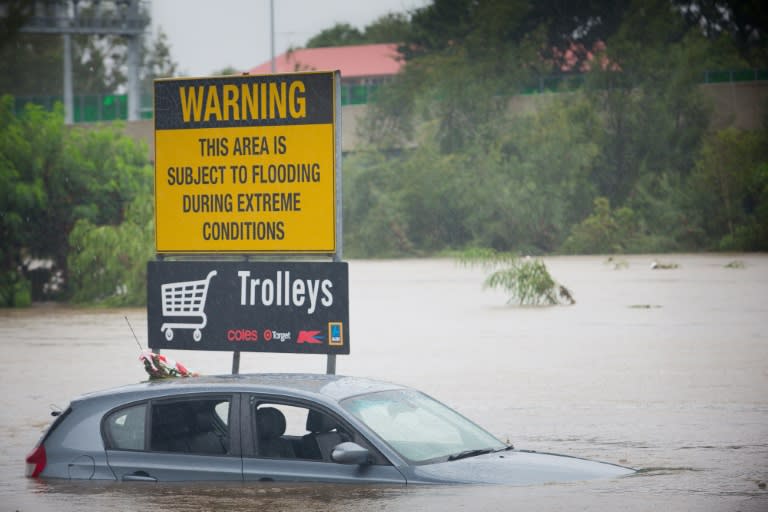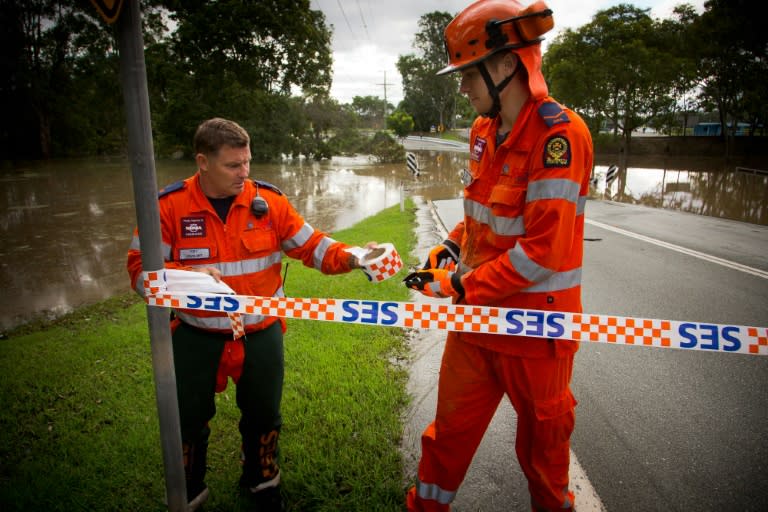Australia evacuates flooded towns after deadly Cyclone Debbie
A second woman's body was found Friday and tens of thousands of people were evacuated from towns in two Australian states after torrential rain caused by a powerful tropical cyclone. Category four Cyclone Debbie hit northeastern Australia on Tuesday between Bowen and Airlie Beach in Queensland state, ripping up trees, washing boats onto land and causing widespread damage. Debbie was downgraded to a tropical low as it tracked southeast, but continued to pack damaging gusts and dump huge amounts of rain all the way down the east coast to New South Wales state, south of Queensland, and Sydney. NSW Police said the body of a woman who "disappeared in floodwaters overnight from a rural property" near Murwillumbah just south of the Queensland border was found on Friday. The body of a 64-year-old woman, whose vehicle was swept off a causeway on a property in Gungal, about 300 kilometres (190 miles) north of Sydney, on Thursday night, was recovered Friday. The woman's 74-year-old husband, who was also in the vehicle, managed to get out. Lismore, south of Murwillumbah near the NSW coast was hard hit, with the State Emergency Service (SES) warning of three-metre (10-feet) high flood levels in the town. Earlier Friday, SES acting deputy commissioner Mark Morrow said he had fears for some missing residents from Lismore. "As we start to go out and try to find people that made... calls overnight, there could be some very distressing news," he told the Australian Broadcasting Corporation. "There could be people overnight that perished in that flood, we don't know at this stage." Other towns subject to evacuation orders include Tweed Heads, Kingscliff and Murwillumbah. Farmer Peter Hannigan, whose property is just north of Lismore, said the deluge was the worst he had ever seen in more than 50 years in the area. "I think a lot of people are going to have a lot of significant damage on the farms," he told the ABC. "It is the worst I have ever seen I have to admit." - Clean-up efforts - Further north in Queensland, the popular tourist city of Gold Coast and other nearby regions were also inundated by water. Upper Springbrook in the Gold Coast hinterland recorded 789 millimetres (31 inches) of water on Thursday, the Bureau of Meteorology said. The weather bureau's regional director Bruce Gunn said that across southeast Queensland, where Gold Coast is located, there had been widespread rainfall of 100-300 mm over the last two days. "In terms of what happened in the last 24 or 48 hours, we have seen some pretty big rainfall totals," he told Brisbane's Courier Mail. "There is still that strong risk around the Gold Coast." Focus has turned to the restoration of essential services such as water and electricity in the areas hit by Debbie, including Bowen, Mackay and the Whitsunday islands where some 50,000 people were still without power, officials said. The military has mobilised 1,300 soldiers to help assess the full extent of damage and aid the clean-up, with helicopters and planes deploying to restore infrastructure and supply emergency food, water and fuel. Queensland Premier Annastacia Palaszczuk said some 2,000 properties had been assessed, with about 270 severely damaged. "The army is doing everything it can to get water into those parts of North Queensland that I mentioned -- Airlie, Proserpine, Bowen and the Whitsunday islands," she told reporters. "We also have structural engineers that are on the ground at the moment." The Insurance Council of Australia declared the Queensland and northern NSW regions disaster zones, adding that the damage bill could reach Aus$1 billion (US $770 million). "The overall event will certainly be in the hundreds of millions of dollars," the council's chief Rob Whelan told reporters Friday. He compared it to Cyclone Oswald, a category five storm which hit in 2013 and caused over Aus$1 billion in damage.





